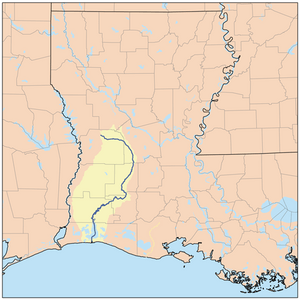Calcasieu River facts for kids
Quick facts for kids Calcasieu River |
|
|---|---|

Calcasieu River watershed
|
|
| Country | United States |
| State | Louisiana |
| City | Lake Charles, LA |
| Physical characteristics | |
| Main source | Confluence of bayous/forests Vernon Parish, Louisiana, United States |
| River mouth | Gulf of Mexico Cameron, Cameron Parish, Louisiana, United States |
| Length | 200 mi (320 km) |
The Calcasieu River (pronounced KAL-kə-shoo) is a river located in southwestern Louisiana, a state in the United States. It flows into the Gulf of Mexico, which is part of the Atlantic Ocean. The river is about 200 miles (320 km) long. It flows through forests and areas with many bayous, which are slow-moving streams or marshy inlets.
The name "Calcasieu" comes from an old Native American language called Atakapa. In their language, katkosh means "eagle" and yok means "to cry." So, the name means "crying eagle."
The River's Journey

The Calcasieu River starts in Vernon Parish, north of a town called Leesville. It first flows towards the southeast. Along its path, it goes through the Kisatchie National Forest.
After that, the river turns southwest. It flows past towns like Oakdale and Lake Charles. Lake Charles is the biggest city located on the river.
The river then reaches the northern part of Calcasieu Lake. This lake is an estuary, which means it's a place where fresh river water mixes with salty ocean water. Locals often call this lake "Big Lake." A 5-mile (8 km) channel connects Calcasieu Lake to the Gulf of Mexico.
Near the city of Lake Charles, a special canal runs alongside the lower part of the river. This canal is used by boats and connects to the Gulf Intracoastal Waterway. This waterway is a system of canals and natural channels that allows boats to travel along the coast.
A Disputed Land in History
In the early 1800s, the land west of the Calcasieu River was a special place. This area, which included parts of what are now Louisiana and Texas, was claimed by both the United States and Spain. They disagreed about where the western border of Louisiana was after the Louisiana Purchase.
Because of this disagreement, the area became known as the "Neutral Ground." It was a place where neither country had full control. This made it a safe haven for privateers. Privateers were like legal pirates who had permission from a government to attack enemy ships.
Caring for the River
The Calcasieu River flows through areas with many industries, including those that refine petroleum. Sometimes, chemicals from these industries can get into the river and its surrounding environment.
One example happened in 1993 when a pipeline spilled a chemical into the river. This chemical was harmful to the environment. The area where the spill happened was later named a "super-fund site." This means it was a place that needed special cleanup because of dangerous pollution.
Cleaning up these chemicals can be very difficult. Some chemicals sink to the bottom of the river and get covered by mud. If the riverbed is disturbed, these chemicals can be stirred up, causing more harm. Companies and environmental groups work together to try and clean up these areas and prevent future pollution. It's important to monitor the river to keep it healthy for plants, animals, and people.
See also
 In Spanish: Río Calcasieu para niños
In Spanish: Río Calcasieu para niños

